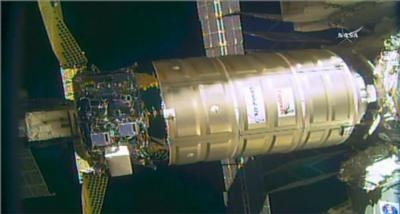"S.S. Alan Poindexter" Spacecraft Delivers More Than 5,300 Pounds Of Cargo, Scientific Experiments
The S.S. Alan Poindexter Cygnus spacecraft successfully completed its rendezvous and berthing procedures with the International Space Station Sunday. This marks the company’s sixth successful berthing with the orbiting laboratory, and the fifth under NASA’s Commercial Resupply Services (CRS-1) contract.

An Orbital ATK Antares medium-class rocket launched Cygnus into orbit on October 17, 2016 marking the return of flight operations to NASA Wallops Flight Facility in Wallops Island, Virginia. Over the past several days, Cygnus executed a series of thruster burns to raise its orbit and reach the space station. Once Cygnus was in close proximity to the station, crew members grappled Cygnus with the station’s robotic arm at 7:28 a.m. (EDT). The spacecraft was then guided to its berthing port on the bottom of the Unity module of the station where installation concluded at 10:53 a.m. (EDT).
“While all of our missions are important to us, the OA-5 mission is distinct and special to the entire Orbital ATK team,” said Frank Culbertson, President of Orbital ATK’s Space Systems Group. “It marked the return to our home base of operations at the Mid-Atlantic Regional Spaceport, where we launched our Cygnus spacecraft atop our upgraded Antares vehicle to deliver critical cargo to the International Space Station. Following our departure from the station, we will again use Cygnus as a platform to conduct scientific experiments for key customers.”
Culbertson added, “To mark so many milestones via one mission represents the tremendous accomplishments of our team. This mission is also special because we named it in honor of an outstanding astronaut, Alan Poindexter, who participated in the construction of the International Space Station on two separate missions.”
Cygnus arrived at the station with 5,300 pounds of cargo, including food, clothing, crew supplies, spare parts, packaging materials, laboratory equipment and scientific experiments. The crew will open the Cygnus hatch and make initial ingress into its cargo module as early as today or later in the week to begin the process of unloading the pressurized cargo. Cygnus will remain berthed at the station for approximately one month before departing with close to 4,000 pounds of disposable cargo.
For the OA-5 mission, Cygnus will conduct two secondary payload missions as part of its flight program, demonstrating its versatility in performing scientific experiments in space. Both payload experiments will be conducted following departure from the International Space Station. The Spacecraft Fire Experiment-II (Saffire-II) will study the behavior of large scale fires in microgravity. The payload will intentionally light a fire in the pressurized cargo module that will grow and advance until it burns itself out. Data from this experiment will be downloaded via telemetry. In addition, using a NanoRacks deployer, the S.S. Alan Poindexter will release several cubesats used for weather forecasting. Upon completion of these secondary payload missions, Cygnus will conduct a controlled, safe, destructive reentry over the Pacific Ocean.
The Cygnus system consists of a common service module and pressurized cargo module. The service module was built and tested at Orbital ATK’s manufacturing facility in Dulles, Virginia. The enhanced Cygnus also uses Orbital ATK’s UltraFlex solar arrays, which are the latest in lightweight, space-qualified, electrical power technology. The arrays were manufactured at Orbital ATK’s Goleta, California facility.
Under the CRS-1 contract with NASA, Orbital ATK will deliver approximately 66,000 pounds of cargo to the ISS over 10 missions through 2018. Upon completion, Orbital ATK will carry out a minimum of six initial cargo missions under NASA’s CRS-2 contract. The partnership is cultivating a robust American commercial space industry, freeing NASA to focus on developing the next-generation rocket and spacecraft that will enable humans to conduct deep space exploration missions.
(Source: Orbital ATK news release)
 Aero-News: Quote of the Day (04.17.24)
Aero-News: Quote of the Day (04.17.24) ANN's Daily Aero-Linx (04.17.24)
ANN's Daily Aero-Linx (04.17.24) Airborne-Flight Training 04.17.24: Feds Need Controllers, Spirit Delay, Redbird
Airborne-Flight Training 04.17.24: Feds Need Controllers, Spirit Delay, Redbird Airborne 04.16.24: RV Update, Affordable Flying Expo, Diamond Lil
Airborne 04.16.24: RV Update, Affordable Flying Expo, Diamond Lil Airborne 04.11.24: SnF24!, King's 50th, Top Rudder, Aileronics
Airborne 04.11.24: SnF24!, King's 50th, Top Rudder, Aileronics



